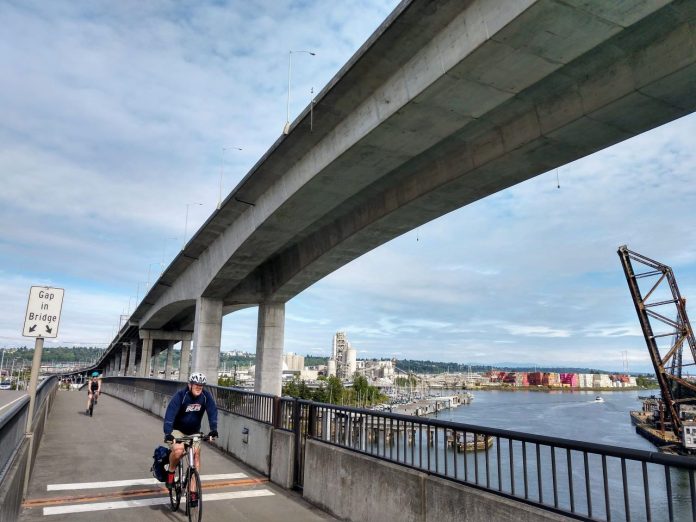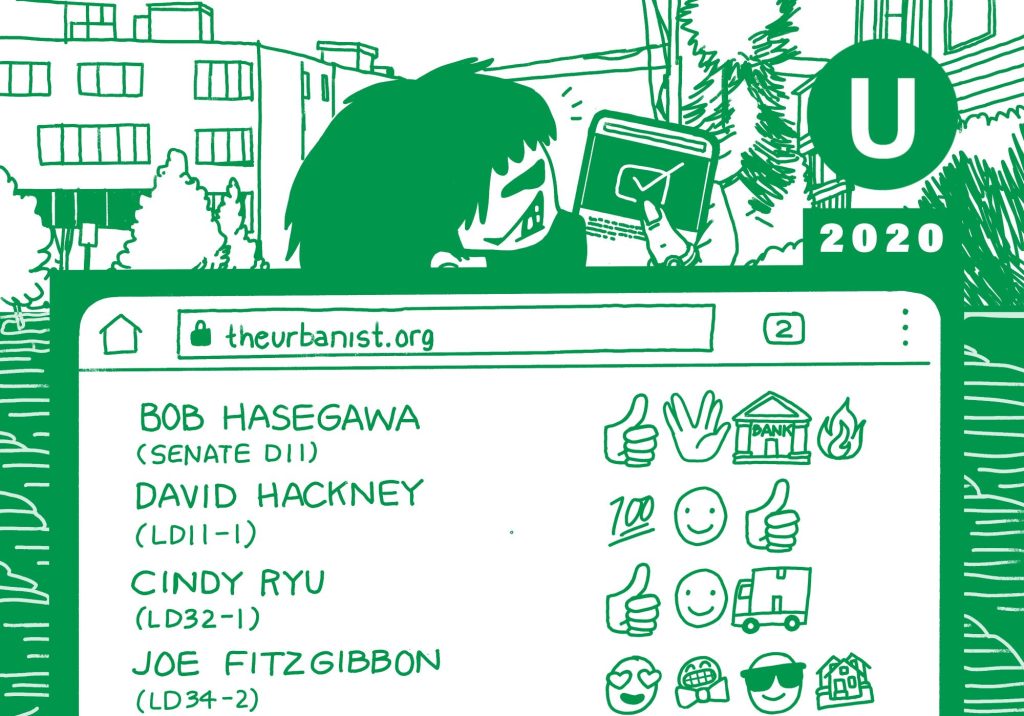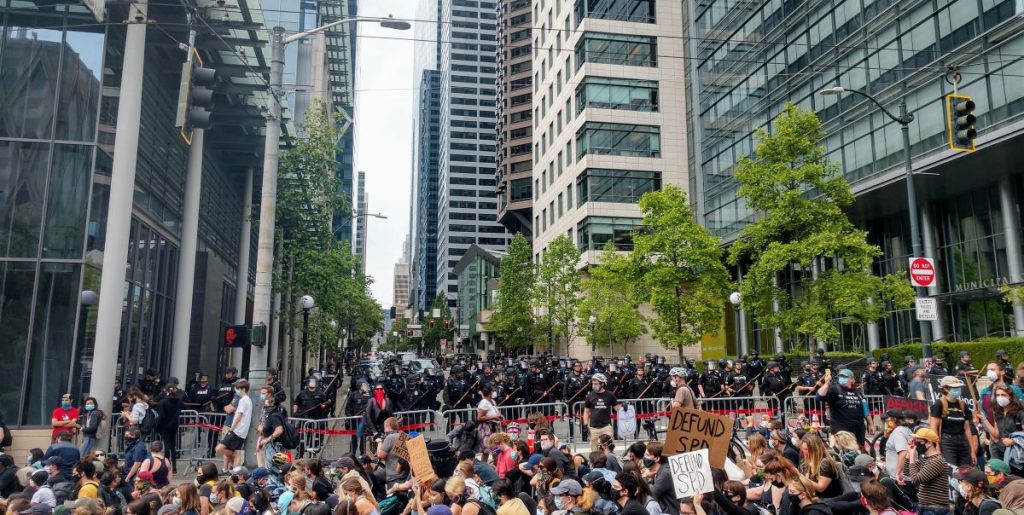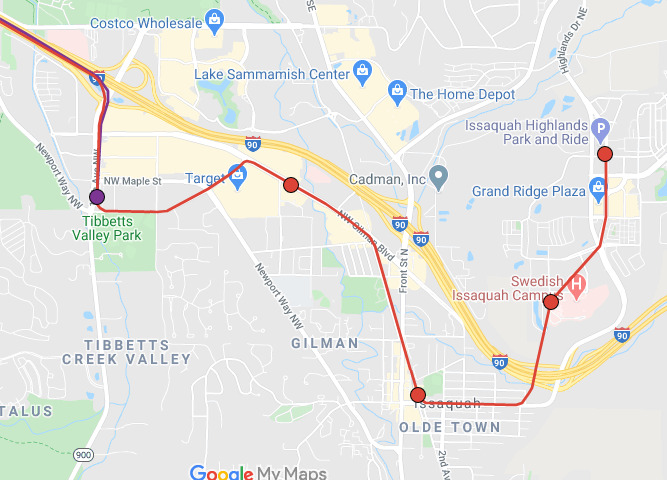
Thank you for reading The Urbanist and making it through a crucible of a year with us. We wanted to look back at our most popular articles as we try to put 2020 in the rearview mirror of our tandem bike, dear reader, as soon as possible–reflecting a smidge and hoping 2021 brings a smoother ride and a non-crumbling bridge to the future.
As a periodic reminder that The Urbanist runs on volunteer contributors. I took the helm as executive director in 2020 and that came with some compensation. But everyone else wrote and edited between the daily toil of some combination of a day job, studies, parenting, and the cabin fever that comes with physical distancing for much of 2020 to evade Covid-19. I’m so thankful to our writers and editors for keeping the dream of an green, antiracist urban utopia alive amidst a lot of… not that. In addition to the pandemic, another event that dominated headlines and our most-read list was what to do about the emergency closure of the West Seattle Bridge.
1) West Seattle Freeway Should Not Be Rebuilt
Love it or hate it, the idea of not rebuilding the West Seattle Freeway generated a great deal of discussion back in April. Brandon Zuo, then writing under the pseudonym Hyra Zhang, argued transit should serve as the main artery into West Seattle rather than a freeway facing emergency repairs for its cracked bridge over the Duwamish River. If we are to meet our climate goals, decreasing vehicle miles traveled has to be part of the solution since transportation is Seattle’s number one source of carbon emissions, and electric cars can only do so much. Why keep building freeways if these goals are serious?
As a high school student, Brandon gets that a grim future awaits young people if we don’t act swiftly. Instead of recognizing the wisdom in the boldness of youth, many local commentators issued scathing rebuttals roasting the idea. In a piece dripping with derision, SeattlePI‘s Joel Connelly suggested the idea of a high schooler writing about the future of this city and planet seems laughable. Connelly was right that Seattle leaders weren’t going to attempt emergency freeway removal, but we’re ultimately going to need Zuo’s boldness to save our planet and its struggling ecosystems.
2) Let’s Build a New West Seattle Bridge That Carries Light Rail
Earlier in April, I wrote a slightly different take arguing Seattle should use the bridge closure to accelerate West Seattle Link light rail construction, killing two birds with one crossing. Working on what information we had then, I argued that light rail should be integrated into the new bridge. Ultimately, the Mayor chose to go the repair route to get the bridge back open sooner and avoid larger upfront costs of a rebuild. Hopefully projections that there’s only a 5% chance the repaired bridge won’t last another 40 years are accurate, and we don’t hit the unlucky collapsing bridge side of that D20.
3) Biden’s Climate Plan Would Launch Green New Deal and High-Speed Rail Network
In August, I wrote about Joe Biden’s new and improved climate plan that would invest $2 trillion in Green New Deal style policies and include a national high speed rail network. Amtrak Joe’s love of trains is one of the brighter spots of his long and winding career. Biden went from getting an ‘F’ from the Sunrise Movement during the primary to getting praises thanks to his more aggressive climate plan.
4) The Urbanist’s 2020 Primary Endorsements
Obviously the election loomed large in 2020 and we want to thank the 7,000 of you who read our primary endorsements. With normal campaign routines interrupted by Covid, The Urbanist Election Committee switched to an online format for its candidate interviews and we were glad to get the chance to question prospective legislators and find some outstanding leaders like Kirsten Harris-Talley and T’wina Nobles, who are both headed to the state legislature.
5) Seattle Council Extends Eviction Moratorium Through December
In May, I covered eviction ban news. The Seattle City Council acted swiftly to provide renters certainty amid a lockdown order and massive layoffs that they would not be evicted in 2020. Governor Inslee extended his eviction ban order only a few months at a time, but ultimately his eviction moratorium has also extended into 2021 after several extensions. Additionally, the Governor has the power to freeze rents, which he thankfully did. The rent freeze may have given new life to efforts to repeal the state rent control ban and open the door to statewide rent stabilization like Oregon enacted in 2019.
6) Police Fleecing City with Overtime, Report Shows
The pandemic wasn’t only a time for stasis and loss. After Breonna Taylor and George Floyd were murdered by police this spring, a reeling nation had finally had enough. We saw a nationwide wave of protests that hadn’t been seen since the civil rights movement of the 60s, and the Seattle Police Department (SPD) leaned on their heavy-handed tactics as usual. Seattle “Defund SPD” protests focused attention on the bloated $409 million police budget with their call to redirect 50% of SPD funding to public health and communities of color. In September, I covered SPD’s overtime budget, which had swelled to $30 million with virtually no actions being taken to rein in this out of control spending.
Paradoxically, SPD has used frequent protests as a pretext to ask for more overtime funding to feed a crowd-control response that is often excessive. In fact, Judge Richard Jones ruled SPD had violated a court-ordered chemical weapons restrictions and held the City in contempt. Facing mounting pressure, the City Council trimmed SPD’s budget by 18% in its 2021 budget, and Mayor Jenny Durkan signed the budget–despite vetoing an earlier rebalancing package over police cuts. Another outcome of the many stumbles over police, racial justice, and protests is that Durkan announced she is not running for reelection in 2021.
7) Let’s Make Bellevue a 15-Minute City
The Urbanist gained a writer specializing in Bellevue coverage this year, and Christopher Randels struck a resonant chord with his article laying out a vision of Bellevue as a 15-minute city. Making Bellevue safe for people walking, rolling, and biking is a life and death matter, as the unrelenting onslaught of traffic deaths and injuries show. 8th Street, in particular, has been deadly and a frequent site of collisions. Randels cofounded Complete Streets Bellevue to press the City for changes necessary to make a safe 15-minute city a reality.
8) Perfecting Issaquah Light Rail
Brandon Zuo made the case for adding more light rail stations in Issaquah to support the city’s transit-oriented development (TOD) plans and better connect the urban core. Even before Covid-triggered delays, Issaquah Link wasn’t scheduled to open until 2041. If Kirkland-to-Issaquah light rail is to succeed, it will take tons of TOD–so best get on that.
9) The Case for a Permanent Center Platform at Pioneer Square Station
Drawing inspiration from a temporary platform during East Link construction, Stephen Fesler argued for a permanent center platform at Pioneer Square Station to improve transfers. Once Sound Transit is operating three light rail lines, a massive amount of transfers are likely to happen at Pioneer Square Station and Chinatown-International District Station.
10) Mayor Durkan Launches Offensive Against Sawant and CHOP After Protest Outside Her Home
On July 1, Mayor Durkan cleared the Capitol Hill Organized Protest (CHOP) and reinstalled SPD in the East Precinct building police had abandoned during protests after exhausting pepper spray canister supplies, turning to tear gas, and being politely asked by Durkan to maybe not tear gas so much. Faced with solving their problems peacefully, police appeared to decide: we’re getting out of here. Protesters took over half a dozen blocks surrounding the East Precinct, pedestrianizing the space and hosting speeches, rallies, art, gardens, and tents to house the homeless. Initially calling the CHOP a summer of love, Durkan’s patience did eventually wear thin.
11) WSDOT Prepares to Open Brand New Seven-Lane Road
The Alaskan Way Viaduct Replacement project is the gift that keeps on giving to motorists. Ryan Packer broke down how a new seven-lane road will continue to keep Denny Triangle inundated with cars and hostile to pedestrians–even with a four-billion-dollar tunnel funneling some of them below ground. Seventh Avenue N will keep memories of the noisy, smelly Alaskan Way Viaduct alive–though the concrete double-decker behemoth was mercifully deconstructed over the past two years. Packer also covered how Elliott Way, a new street feeding a widened Alaskan Way Boulevard is also overbuilt despite aspirations of a waterfront park and relaxation space. The Washington State Department of Transportation and the legislators who keep infusing it with highway-building cash need an intervention.
If you counted on stories like these to make sense of 2020, please subscribe or make a one-time donation. The Urbanist runs on support from readers like you.
Doug Trumm is publisher of The Urbanist. An Urbanist writer since 2015, he dreams of pedestrian streets, bus lanes, and a mass-timber building spree to end our housing crisis. He graduated from the Evans School of Public Policy and Governance at the University of Washington in 2019. He lives in Seattle's Fremont neighborhood and loves to explore the city by foot and by bike.





